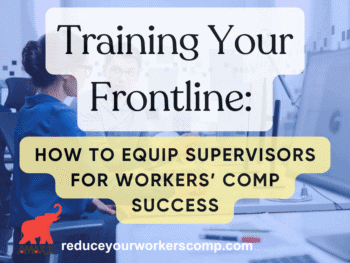
This two-part series will explore steps to improve the claims process and drive workers’ compensation claims toward settlement. A focus will also be on promoting workplace morale and empathy.
Proper Training for Effective Injury Response
There are several components to an effective injury response. Some of these often go ignored. What is done at the time of injury can prevent excessive workers’ compensation costs down the road and ensure the correct decision is made regarding primary liability. Now is the time to consider what you are doing in your work injury.3-Part Series Box
This post is one in a 2-part series:
- Stabilize the injured employee and ensure that person receives the best medical care: This requires all employees to receive first aid training and have access to a properly stocked first aid kit designed with the workplace in mind. Know the common work injuries and determine what supplies are missing. Make sure everyone knows how to summon emergency medical services if needed.
- Document the work injury ultimately: Make sure supervisors and upper management know who to ask the common reporter questions – who, what, when, where, how, and why—supplying all employees with the proper tools to report the event in unwitnessed injuries. Consider providing incentives for timely reported work injuries and what information should be collected. Provide the same incentives to supervisors for a safe workplace (injury-free days) and ensure that injuries are reported timely.
- Provide other resources to treat injuries better: There are many tools out there that, when used properly, can allow better control of a workplace injury and mitigate costs. Examples include telephone nurse triage and establishing an employer Preferred Provider Organization (PPO). Nurse triage is used to assess a work injury and provide an evidence-based medical assessment to a supervisor. This will allow that person to provide the best medical care possible. Using an employer PPO will allow for better medical care directions to facilities with a contract that provides medical services at a lower cost. They also help ensure consistency.
Empathy and compassion are part of providing an adequate response. Consider contacting the injured employee the day after the injury to check their well-being.
Best in Class Claim Investigations
Once the claim is reported promptly, the best investigation possibly takes place is vital. When it occurs, members of the claim management team will have all the information possible to make the right decision regarding admitting or denying primary liability. Even if liability is admitted, the best possible investigation will provide the claim handler with the necessary information to manage the file and move it toward resolution.
- Preserve and document the scene: The injury scene needs to be preserved and documented. This can include using tools such as smartphone app-based programs where the employee can accurately record information, take photos, and upload the information to the insurance carrier or third-party administrator. Proper documentation is also helpful in instances such as a defective machine in the workplace or a slippery floor where proper remediation is needed to prevent future incidents.
- Collect Data: Plenty of information needs to be collected as described above. When collecting data, it must be accurate. Common errors include transposing telephone numbers or other numeric information, misspelling names, incorrect names of witnesses, etc. Training supervisor on techniques to ensure the accuracy of all information.
- Determine root causes: Workers’ compensation is a “no-fault” system meaning common law defenses such as contributory negligence are not appliable. Examining the cause of an injury can improve the system and should be done to reduce the frequency of certain types of injuries in the future. Keeping in mind injury prevention is crucial.
- Implement corrective actions: This is where a safety committee can play an important role. Information gathered in a complete investigation can improve the workplace beyond reducing the frequency and severity of injuries. It can increase workplace morale, which is priceless.
The investigation phase of a work injury is the right time to analyze possible subrogation claims. Collaborative opportunities in workers’ compensation claims include motor vehicle accidents, product liability cases, or incidents occurring on a third-parties premise.
Conclusions
Running the best workers’ compensation program requires involvement from all levels within the employer’s organization at the claim management team. Focusing on a proper injury response and the best investigation possible will drive efficiencies within a program and reduce workers’ compensation costs. Now is the time to consider change within your program.
Stay tuned for part two on focusing on the fundamentals within your program for more great ways to improve your processes.
 Author Michael Stack, CEO Amaxx LLC. He is an expert in workers’ compensation cost containment systems and helps employers reduce their workers’ comp costs by 20% to 50%. He works as a consultant to large and mid-market clients, is a co-author of Your Ultimate Guide To Mastering Workers Comp Costs, a comprehensive step-by-step manual of cost containment strategies based on hands-on field experience, and is the founder & lead trainer of Amaxx Workers’ Comp Training Center, which offers the Certified Master of Workers’ Compensation national designation.
Author Michael Stack, CEO Amaxx LLC. He is an expert in workers’ compensation cost containment systems and helps employers reduce their workers’ comp costs by 20% to 50%. He works as a consultant to large and mid-market clients, is a co-author of Your Ultimate Guide To Mastering Workers Comp Costs, a comprehensive step-by-step manual of cost containment strategies based on hands-on field experience, and is the founder & lead trainer of Amaxx Workers’ Comp Training Center, which offers the Certified Master of Workers’ Compensation national designation.
Contact: mstack@reduceyourworkerscomp.com.
Workers’ Comp Roundup Blog: http://blog.reduceyourworkerscomp.com/
©2022 Amaxx LLC. All rights reserved under International Copyright Law.
Do not use this information without independent verification. All state laws vary. You should consult with your insurance broker, attorney, or qualified professional.

















